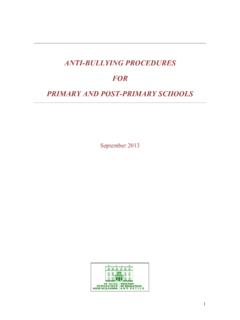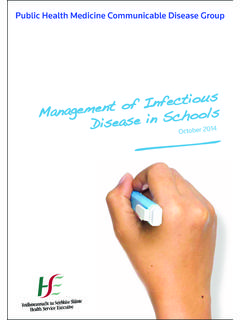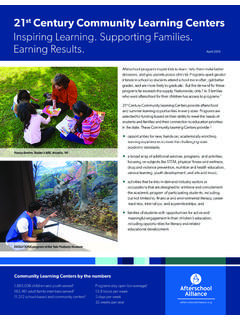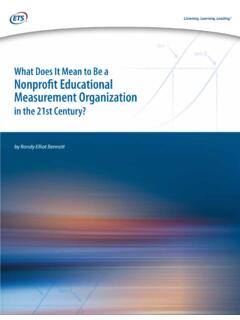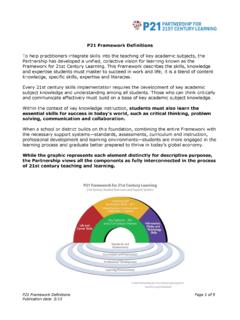Transcription of Further Education and Training Strategy
1 Further Education 2014 2019 Further Education and Training Strategy2014 2019and Training Strategy 1 Further Education and Training Strategy 2014 2019 2 Published by SOLAS 3 Preface The Further Education and Training Act 2013 was signed into law in July 2013. It provided for the dissolution of F S and the establishment of SOLAS. SOLAS is required by the Act to propose a five- year Strategy for the provision of Further Education and Training (FET). SOLAS operates under the aegis of the Department of Education and Skills and will, in conjunction with the sixteen Education and Training Boards, be responsible for the integration, coordination and funding of a wide range of Further Education and Training programmes.
2 The SOLAS Action Plan states that SOLAS will be tasked with ensuring the provision of 21st century high- quality FET programmes which are responsive to the needs of learners and the requirements of a changed and changing economy. The FET Strategy is intended therefore to provide a focus for the setting of investment priorities, and to provide a framework for the establishment and development of a strong FET sector. The FET Strategy aims to deliver a higher quality learning experience leading to better outcomes for all those who engage in FET. It presents a roadmap and implementation plan to realise the vision of a world- class integrated system of Further Education and Training in Ireland which will: support economic development; increase social inclusion; and meet the needs of all learners, communities and employers who engage with FET.
3 The FET Strategy is set within a context of Government reform of public services. The FET Strategy also reflects the priorities articulated in the Action Plan for Jobs , Pathways to Work and wider policy reform in Education . The Action Plan for Jobs is a key component of the Government s integrated response to the unemployment crisis and involves all of Government including the Department of Education and Skills. The Education and Training system is a core part of the enterprise, development and innovation infrastructure. A key priority for the Education and Training system, including FET, is to: Address the unemployment challenge and provide targeted skills programmes that support job seekers to re- skill and up- skill for areas where sustainable employment opportunities are emerging.
4 Modernise and expand the apprenticeship system. Implement the new structures for FET to deliver higher quality flexible and responsive programmes. The Pathways to Work initiative is another key component of Government response to the unemployment crisis. This initiative focuses on unemployed people; in particular those who are long term unemployed and young unemployed people. The aim is to provide priority access for 4 unemployed people to relevant labour market opportunities to enhance their job prospects through Education and Training programmes and work experience.
5 Reform in Education is broadly focussed on improving quality, accountability and supporting inclusion and diversity in schools. With regard to higher Education and Further Education and Training , reform is focussed on creating the right opportunities for Irish adults. Clearly, skills development and wellbeing lie at the heart of the FET Strategy . Employers lie at the heart of skill needs, while the learner lies at the heart of the FET service. The benefits from investment in skills at all levels are numerous and span both the economy and society. Social benefits concern individual's success in effectively and constructively participating in social, civic and working life.
6 The evidence shows that literacy and numeracy skills have a significant impact on gaining employment while community Education empowers people to grow in confidence in their own employability and engage effectively with the labour market. It is worth noting that the majority of SOLAS funding is currently targeted at full time FET programmes at National Framework of Qualifications (NFQ) levels 1- 6 and many of these programmes have a vocational and employment aim. The main focus of the Strategy therefore is to provide the following skills through FET: Skills as a resource for economic growth: a skilled, innovative and flexible labour force has become a key resource for sustained economic growth.
7 Numerous studies have shown links between economic growth and human capital and increasing returns from Education and Training . Skills as drivers of employment growth: employment growth in many developed countries has been concentrated in high skilled areas ( IT services, research and development (R&D), engineering services, financial services and consultancy etc.) which through spin offs drive job creation in other sectors. Creating an indigenous engine of economic growth in Ireland is also central to the revitalisation of the Irish economy. Entrepreneurship, and the start- up companies that emerge as a result, provide employment and the means by which new sectors take root in Ireland.
8 Skills as drivers of productivity increase: along with technological advances, skills represent a key source of productivity increases. Skills and smartening of the economy: driven by technological advances and globalisation, all jobs are becoming knowledge intensive and the economy is moving from a capital to a knowledge- based one. 5 Skills as a driver of social inclusion and social mobility: regardless of age and circumstances, having the right skills and the opportunities to use and develop them in order to gain confidence and self- esteem is essential to contribute to a better society, as well as to improve employability and productivity.
9 The ability to transfer those skills to new situations and to be able to communicate, including through technology, in a way which suits individual circumstances and aspirations is at a premium in an evolving knowledge- based economy. Skills as an insulator from unemployment: as job security gives way to labour market flexibility and the focus moves from a job for life to work for life , only through continuous skills development and lifelong learning can participants in the labour market ensure employability, skills transferability and reduce the risk of unemployment, particularly long- term unemployment.
10 With regard to skills as an insulator from unemployment, the fact that many of those who have become unemployed in recent years have relatively low formal qualifications has raised the fear that long- term unemployment may become an embedded feature of the labour force of many Western economies (structural unemployment). The high economic and social costs associated with such a scenario have added a sense of urgency to the process of skill- upgrading of unemployed persons. A common feature in many well- developed Education and Training systems is an emphasis on the development of skill credentials that are approved by industry, that are often transferable across different sectors and, most importantly, can be arranged or stacked up as a sequence of awards that are accumulated by job- seekers advancing along specific and identifiably viable career pathways.

